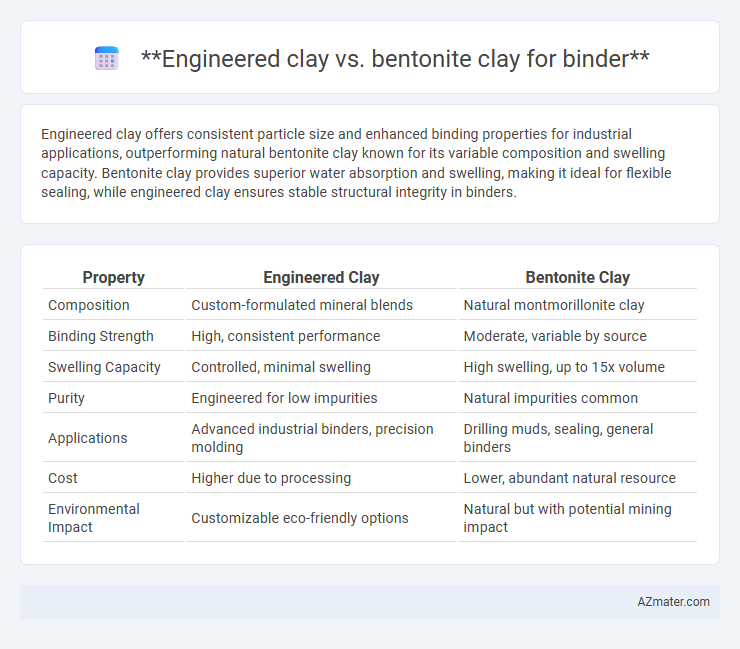Engineered clay offers consistent particle size and enhanced binding properties for industrial applications, outperforming natural bentonite clay known for its variable composition and swelling capacity. Bentonite clay provides superior water absorption and swelling, making it ideal for flexible sealing, while engineered clay ensures stable structural integrity in binders.
Table of Comparison
| Property | Engineered Clay | Bentonite Clay |
|---|---|---|
| Composition | Custom-formulated mineral blends | Natural montmorillonite clay |
| Binding Strength | High, consistent performance | Moderate, variable by source |
| Swelling Capacity | Controlled, minimal swelling | High swelling, up to 15x volume |
| Purity | Engineered for low impurities | Natural impurities common |
| Applications | Advanced industrial binders, precision molding | Drilling muds, sealing, general binders |
| Cost | Higher due to processing | Lower, abundant natural resource |
| Environmental Impact | Customizable eco-friendly options | Natural but with potential mining impact |
Introduction to Clay Binders in Industry
Engineered clay and bentonite clay serve crucial roles as binders in various industrial applications due to their unique physicochemical properties. Bentonite clay, primarily composed of montmorillonite, offers superior swelling capacity and plasticity, making it ideal for drilling fluids, foundry molds, and pelletizing processes where strong adhesion and shape retention are essential. Engineered clays, modified through processes like acid activation or thermal treatment, provide tailored binding characteristics, enhanced rheology control, and improved thermal stability, addressing specific industry requirements beyond the natural limitations of bentonite.
What is Engineered Clay?
Engineered clay is a specially processed material designed to enhance binding qualities for industrial and environmental applications, often modified to improve plasticity, permeability, and chemical reactivity. Unlike natural bentonite clay, which primarily consists of montmorillonite with high swelling capacity, engineered clay is tailored through additives or treatment processes to meet specific performance criteria such as improved mechanical strength and controlled absorption. This customization makes engineered clay particularly suitable for use as a binder in pharmaceuticals, construction, and wastewater treatment where precise material properties are critical.
What is Bentonite Clay?
Bentonite clay is a natural absorbent composed primarily of montmorillonite, widely used as a binder due to its excellent swelling properties and strong adhesive qualities. Engineered clay, on the other hand, is chemically modified bentonite or similar clays designed to enhance specific binding attributes such as improved thermal stability or reduced shrinkage. Bentonite's unique structure allows it to trap and hold water molecules, making it highly effective in applications requiring moisture retention and structural cohesion.
Key Differences: Engineered Clay vs Bentonite Clay
Engineered clay offers customizable properties such as enhanced particle size distribution and tailored chemical composition, improving its binding strength and performance compared to natural bentonite clay. Bentonite clay, primarily composed of montmorillonite, provides strong swelling and adsorption characteristics but lacks the uniformity and specialized features found in engineered clays. The key differences lie in engineered clay's controlled manufacturing process versus bentonite's natural variability, impacting consistency, reactivity, and application suitability in binder formulations.
Performance Comparison: Binding Strength
Engineered clay exhibits superior binding strength compared to bentonite clay due to its tailored particle size distribution and enhanced surface chemistry, resulting in more effective adhesion in various applications. Bentonite clay, while naturally endowed with good swelling properties, often demonstrates lower binding consistency under high-stress environments. Performance tests reveal that engineered clay maintains structural integrity and resistance to shear forces better, making it the preferred binder in demanding industrial processes.
Water Absorption and Retention
Engineered clay exhibits superior water absorption compared to bentonite clay, with absorption rates reaching up to 200%, enhancing its effectiveness as a binder in various industrial applications. Bentonite clay, known for its high swelling capacity, offers exceptional water retention, maintaining moisture levels over extended periods, which is critical in construction and drilling operations. The choice between engineered clay and bentonite clay often depends on specific project requirements, where engineered clay is preferred for rapid absorption and bentonite clay for sustained moisture control.
Environmental Impact and Sustainability
Engineered clay offers a tailored mineral composition that reduces environmental disruption during extraction compared to bentonite clay, which often requires extensive mining and water usage. Bentonite's high swelling capacity can lead to challenges in waste management and potential soil contamination, whereas engineered clay formulations are designed for improved biodegradability and lower ecological footprints. Sustainable sourcing of engineered clay supports circular economy principles by minimizing land degradation and promoting efficient resource utilization.
Cost Analysis and Economic Considerations
Engineered clay offers a higher upfront cost compared to bentonite clay but can provide enhanced performance and durability in binder applications, potentially reducing long-term operational expenses. Bentonite clay remains a cost-effective option due to its widespread availability and lower price point, making it economically viable for large-scale projects with budget constraints. Economic considerations include balancing initial material costs against lifecycle benefits, with engineered clay favored in settings prioritizing longevity and bentonite preferred for cost-sensitive applications.
Industrial Applications: Where Each Clay Excels
Engineered clay offers superior consistency and tailored particle size distribution, making it ideal for high-precision industrial binders in ceramics and foundry applications. Bentonite clay excels in applications requiring high swelling capacity and strong binding properties, such as drilling muds, iron ore pelletizing, and environmental sealing. Each clay's unique rheological and chemical characteristics determine its suitability, with engineered clays preferred for uniformity and bentonite favored for natural adsorption and expandability.
Choosing the Right Clay Binder: Factors to Consider
Engineered clay offers consistent particle size and enhanced plasticity, making it ideal for high-strength binder applications requiring uniform performance. Bentonite clay provides superior swelling capacity and excellent water retention, beneficial for sealing and drilling operations where flexibility is crucial. Selecting the right clay binder depends on factors such as required binding strength, environmental conditions, and compatibility with other materials in the formulation.

Infographic: Engineered clay vs Bentonite clay for Binder
 azmater.com
azmater.com